In one of his letters sent to Michelangelo Buonarroti (Caprese, 1475 - Rome, 1564) in September 1537, the great Pietro Aretino, one of the greatest men of letters of his time, said that “the world has many kings, and only one Michelangelo”: in fact, already the contemporaries of the great Tuscan artist had a perception of the greatness of his genius, one of the greatest in the entire history of art. We can consider Michelangelo’s experience unrepeatable: perhaps the greatest sculptor of all time, he marked a fundamental watershed with his art; many artists after him would try to imitate him without even coming close to his results, and his inspiration continues to provide insights and suggestions centuries later. He also had an unusually long life for his time, as he lived eighty-nine years: an extremely intense life, passing through different seasons and experiences. From the Florence of the Medici to that of Savonarola, from the defense of the Florentine Republic to the Rome of the popes. And then, the rivalry with Raphael and Leonardo da Vinci, the clashes with his patrons, his solitary character, stormy and irascible but who could also reach incredible heights of sensitivity, of which Michelangelo has given us proof with his very delicate Rime. An existence, in essence, unique.
Michelangelo’s works are one of the reasons why every year thousands of tourists and travelers come to Rome or Florence, but also to other Italian centers (his works are preserved, in fact, not only in the capital and the Tuscan capital), to visit the museums and chise that preserve them. His genius, moreover, was multifaceted: Michelangelo was not only a sculptor, but also a painter, architect and poet, and his works were unparalleled in strength and energy, but also in complexity and sophistication of content, as well as in their tension, which immediately makes us also feel the inner dissensions experienced by their creator (Michelangelo was one of the most tormented artists in history: perpetually dissatisfied with his own achievements, he led an almost miserable life despite having accumulated fabulous wealth, which he employed mostly for land investments). There were also many personalities whom the artist met or for whom he had the opportunity to work: from Lorenzo the Magnificent to Pope Julius II, from the Medici popes (Leo X and Clement VII) to Francis I of France, not to mention the countless artists and men of letters who crossed his path (out of all of them it will be worth mentioning at least Vittoria Colonna, to whom he was linked by an intense friendship).
What was the greatness of this unique artist, torn by contradictions and torments? What are his major works and where can they be seen? Let us trace a path to discover the art of Michelangelo Buonarroti, without neglecting some highlights of his biography.
 |
| Daniele da Volterra, Portrait of Michelangelo (c. 1544; oil on panel, 88.3 x 64.1 cm; New York, The Metropolitan Museum of Art) |
Michelangelo Buonarroti was born in Caprese, Aretino, on March 6, 1475, to Ludovico Buonarroti, a Medici official (he held the position of podestà of Caprese) from a family of ancient nobility but which had lost the prestige it had acquired in the past, and Francesca di Neri. Michelangelo’s family had no artistic background: the child was the only one to show talent for art, despite the fact that the family wished to launch him into a literary career in part to ensure a future for the child with brighter economic prospects than hisig enitors enjoyed. The hardships in which the family was forced to live probably forever marked the character of Michelangelo, who throughout his life was always very frugal and careful with money. However, despite what we learn from early biographers, his father probably did not hinder him in his artistic career, not least because the very young Michelangelo, placed in an artist’s or craftsman’s workshop, could still have learned a trade that would have given him a living. So in 1487 he entered the workshop of Domenico del Ghirlandaio and completed his apprenticeship there: towards the end of the decade, however, he began to attend the school in the garden of San Marco, founded by Lorenzo the Magnificent, where he became a pupil of Bertoldo di Giovanni and made a name for himself with the lord of Florence.
After the fall of the Medici, he stayed for some time in the convent of Santo Spirito in Florence, as a guest of the prior, and there he was able to study anatomy in depth, improving his qualities. After sojourning in Venice and Bologna he returned to Florence, where he executed a lost San Giovannino for Lorenzo di Pierfrancesco de’ Medici, and together with the latter he hatched a deception against Cardinal Raffaele Riario, sculpting a Cupid to be resold to the prelate as an original Roman antiquity. Riario smelled the scam, discovered it and was angry, but he wanted to meet the talented artist, and gave him the first commission: it was the famous Bacchus (which was later perhaps rejected by the cardinal), now in the Bargello Museum. In the meantime, the artist had moved to Rome in 1496: shortly afterwards he received the commission to sculpt the Vatican Pietà from Cardinal Jean Bilhères de Lagraulas. To create it, the artist went to Carrara for the first time in his career in order to choose the marbles: the work was delivered to the cardinal in 1499 and opened the doors of success for the young artist, just 24 years old.
His career was then a steady crescendo: in 1500 he returned to Florence, where the Republic, the following year, commissioned him to paint the David, completed in 1504, and also in 1504 he was commissioned to make the Battle of Cascina in the Sala dei Cinquecento in the Palazzo Vecchio (the work never came to fruition and is known to us only through copies). Later the artist returned to Rome, where Pope Julius II commissioned his own funeral monument: the work would be finished, following numerous delays, many years after the pontiff’s death, and different from the original design. The monument includes the famous Moses executed starting in 1513. In 1508, Julius II again commissioned Michelangelo to execute the frescoes of the vault of the Sistine Chapel: the artist did not consider himself a painter and was at his first trial with the fresco technique, so he reluctantly accepted, but his work, discovered in 1512, impressed his contemporaries (even Raphael was profoundly influenced by it). Back in Florence, in 1516, at the behest of the new pope Leo X he executed some plans for the facade of the Florentine basilica of San Lorenzo (this work, too, would never be realized).
In 1520 Michelangelo executed the famous Prigioni for the monument to Julius II, which were unfinished and are now in the Accademia Gallery in Florence. In the same year Cardinal Julius de’ Medici entrusted him with the creation of the New Sacristy of San Lorenzo, one of his greatest masterpieces, completed about fifteen years later. Returning to Florence in 1526, he was appointed procurator of the fortifications of the Florentine Republic: the following year the Medici seigniory was restored, and although Michelangelo was a fervent republican he nevertheless resumed working for the Medici. Returning to Rome in 1532, to settle there permanently in 1534, he met Tommaso Cavalieri and Vittoria Colonna, to whom he dedicated several of his poems. Probably beginning in this year he began composing his Rime, which would be published posthumously in the following century by his nephew Michelangelo Buonarroti the Younger. In 1536, on the other hand, the artist began work on the Last Judgment, finished in 1541, and in 1542 Pope Paul III commissioned him to execute the frescoes in the Pauline Chapel: the Conversion of St. Paul, finished in 1545, and the Crucifixion of St. Peter, executed between 1546 and 1550 (these are his last pictorial works). In 1545, forty years into the commission, Michelangelo finally finished the funeral monument to Julius II, although in a radically different manner from the original. In 1547 the artist was appointed architect of St. Peter’s, and around 1548 he executed one of his late masterpieces, the Bandini Pietà. In 1552 he began work on the Rondanini Pietà, which would remain unfinished at the date of his death, however: this was the sculptor’s last work. In 1558 he began making the model for the dome of St. Peter’s, which was finished in 1561. The work would later be carried out at the end of the century by Giacomo della Porta, who followed, albeit with some modifications, Michelangelo’s original design. On February 18, 1564, Michelangelo died in Rome, and after the solemn funeral (whose famous oration was prepared by the great man of letters Benedetto Varchi), by his will he was buried in Florence.
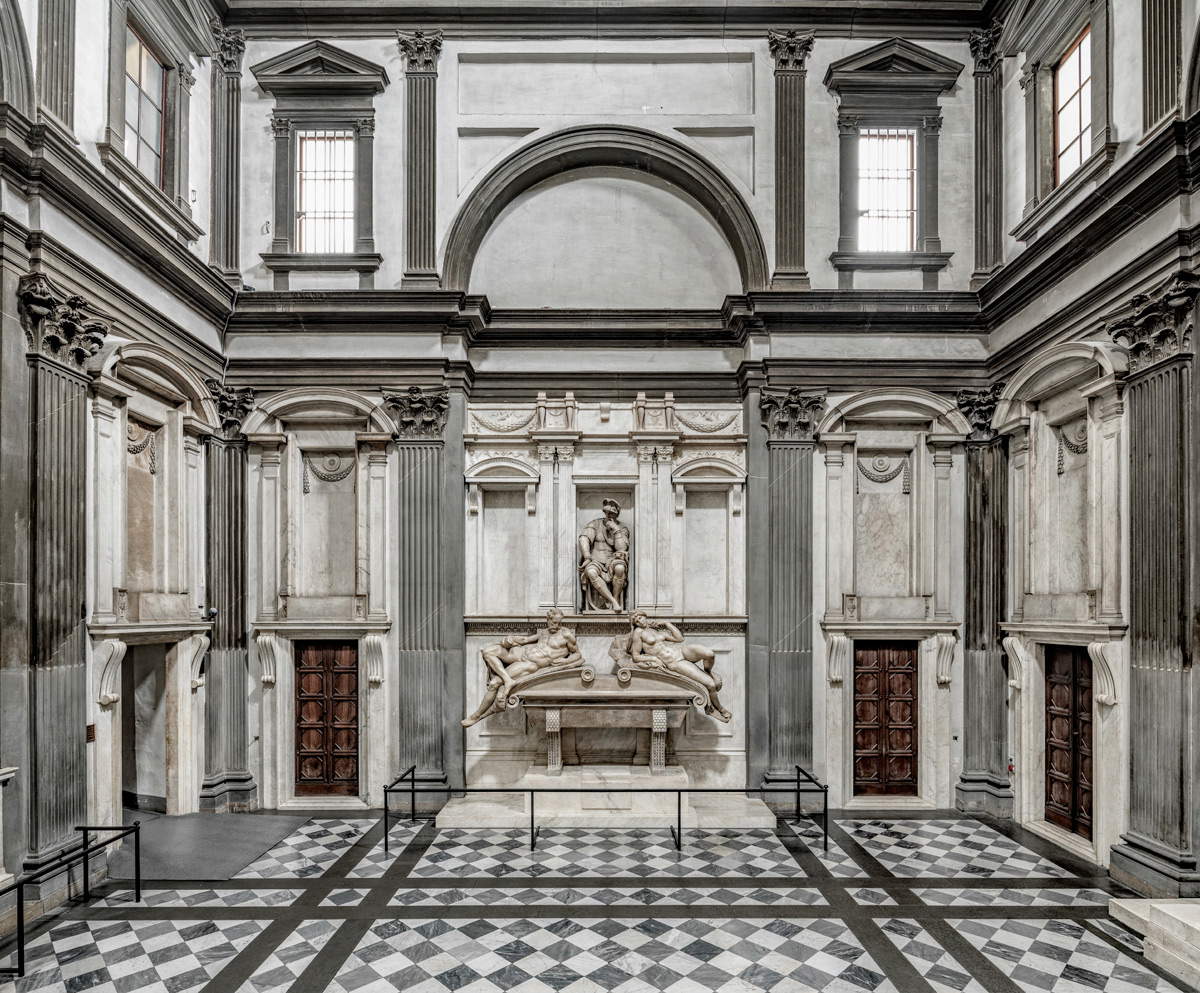 |
| The New Sacristy, seen with the tomb of Lorenzo Duke of Urbino. Ph. Credit Andrea Jemolo |
As anticipated, Michelangelo made his debut at a very young age, in the circle of Lorenzo the Magnificent, where he had the opportunity to study the works of the greatest artists starting with Giotto and ending with the greats of the Renaissance such as Masaccio and especially Donatello. To understand how Michelangelo got his start, it is necessary to take a closer look at his early works, created when he was about fifteen years old: the Madonna della Scala (circa 1490) and the Battle of the Centaurs (1490-1492). The former is a work heavily indebted to Donatello’s style (Michelangelo uses the technique of stiacciato), while the Battle of the Centaurs is a work that already surpasses his master Bertoldo di Giovanni, who had made a similar work shortly before (read also the detailed in-depth study of Michelangelo’s two early masterpieces). Today both works are preserved in Florence at Casa Buonarroti.
To begin to understand Michelangelo’s greatness, it is necessary to take a closer look at the Vatican Pietà. Michelangelo solved in an original and innovative way a theme that gave artists a way to create suffering works: the purity, delicacy and composure of the Madonna, with her face with adolescent features, amazed the artist’s contemporaries. One of the reasons for the greatness of this work lies precisely in thehumanity that the artist knew how to instill in his characters: never before had anything like this been seen. Jesus, despite the sufferings he endured on the cross, seems almost unscathed, and even in the beauty and precision of the rendering of this body supported by his mother, the divine nature of Christ seems to manifest itself, as if to say that death and suffering have failed to offend that body of his that denotes all of Michelangelo’s study of classical statuary. With his Pieta, moreover, the young Buonarroti offered observers an essay of his virtuosity: the Pieta is, moreover, one of Michelangelo’s works that achieves the highest levels of smoothness and finesse, as opposed to the works of his maturity, which would almost all be left in that state of unfinishedness that characterizes many of Michelangelo’s masterpieces.
The Pieta is also a fundamental work for learning about Michelangelo’s relationship with marble: the artist rough-hewn the marble directly at the quarry site so as to facilitate transportation and avoid inconveniences due to veining or imperfections that the blocks might have within them, and even in 1517 he partnered with a marble quarry owner so as to earn money on the commissions of the quarried blocks as well, although this move got him into trouble with the Medici, who required Michelangelo to source marble from the quarries in Pietrasanta because they were in Medici territory (Carrara, on the other hand, was part of an independent state).
 |
| Michelangelo, Madonna della Scala (c. 1490; marble, 56.7 x 40.1 cm; Florence, Casa Buonarroti, inv. 190) |
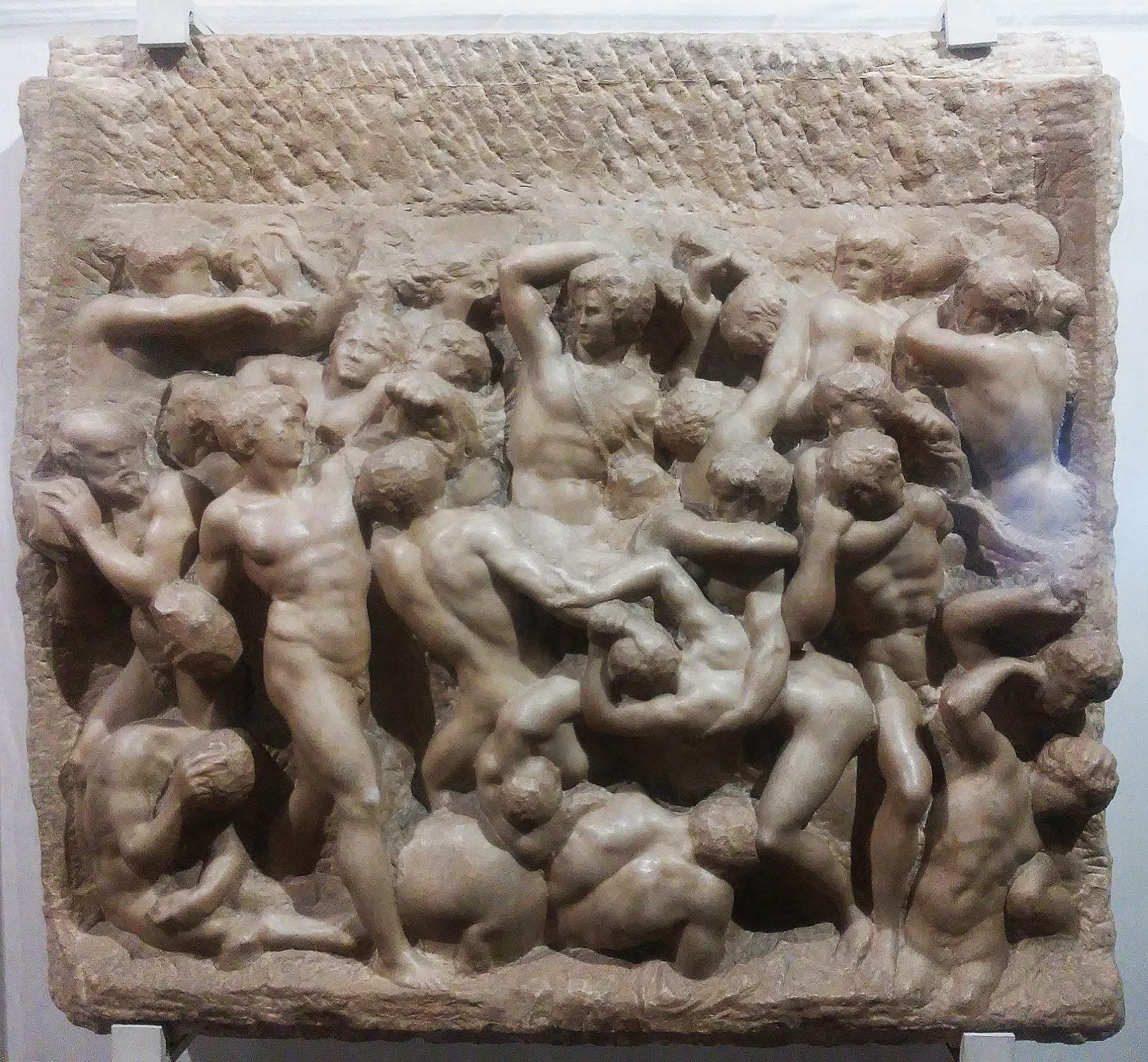 |
| Michelangelo, Battle of the Centaurs (c. 1490-1492; marble, 80.5 x 88 cm; Florence, Casa Buonarroti, inv. 194) |
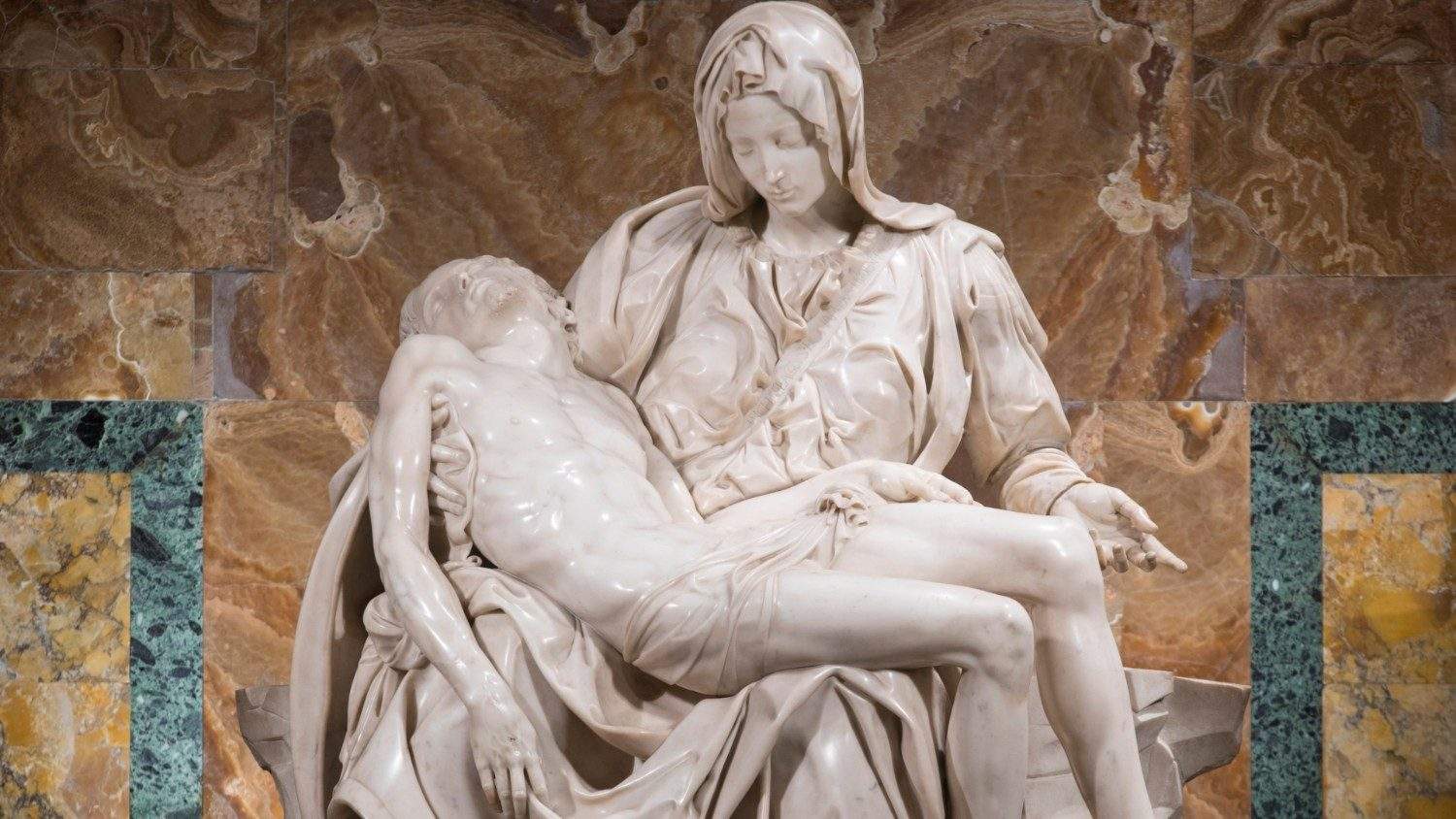 |
| Michelangelo, Pieta (1497-1499; marble, 174 x 195 cm; Vatican City, St. Peter’s Basilica) |
When people think of a model of perfection and masculine beauty, they probably think of Michelangelo’s David: commissioned in 1501, it was finished in 1504, and proved to be an imposing work, four meters in height. The body of the David, despite its youthful features, is made an expression of strength and vigor, the muscles are in relief, the fingers rendered with a very high anatomical precision as well as the tendons of the neck: these are the elements make the David an unsurpassed masterpiece, and even at the time Michelangelo’s contemporaries felt that they were facing an immense masterpiece. This was not only because of the exceptional beauty of the work, but also because it was a highly symbolic work: the young David resisting the giant Goliath, the invader, was seen as a metaphor for the resistance of the Florentine republic against its enemies and was seen above all as a metaphor for freedom and rebellion against tyranny. A work that seems to be of classical setting but is instead of a very modern conception: a modernity that we find not only in Michelangelo’s interest in the anatomical rendering of every single part of the body, but also in the way the artist communicates to the viewer certain aspects such as the moral strength of the David (emphasized not only by his wrinkled forehead but also by his nudity). And a modernity that is also evident in the absence of some typical David motifs, such as the head of Goliath or the sword, which Michelangelo does not bring back because it is not so much the depiction of the episode that interests him as the moral and human significance of its protagonist.
The Tondo Doni, a masterpiece preserved in the Uffizi, is the only existing panel painting that can be referred to Michelangelo with certainty, so it is a work of the highest value. It was probably commissioned from Michelangelo on the occasion of the wedding of Angelo Doni and Maddalena Strozzi, who are also the two protagonists of Raphael’s very famous portraits preserved in the same room. It is a unique, highly original painting: first of all because of the pose of the Holy Family, which is innovative, with the Madonna kneeling and twisting and looking backward as she takes the Child Jesus on her shoulder. The figures of the protagonists are sculptural, showing great vigor, exhibiting strong chiaroscuro and a very sharp outline that makes them stand out from the background of the painting. We note that male nudes appear behind the protagonists: scholars have long wondered about their significance. You can learn more about the history of the Tondo Doni and the interpretation of its meaning by reading the article we dedicated to it.
But it is not the only masterpiece in painting by Michelangelo: if you think of his painting, it comes almost naturally to imagine the magnificence of the vault of the Sistine Chapel. As anticipated in the biography, it was commissioned from him by Pope Julius II in 1508. According to the testimony of Michelangelo himself, the pope would have wanted only the depictions of the apostles to appear on the vault, but Michelangelo suggested a different decoration to him instead: in the central part nine scenes from the Old Testament, the most famous of which is undoubtedly the creation of Adam, then in the sails and lunettes the ancestors of Jesus, and on the sides of the stories the sibyls and prophets, for a mixture of Christianity and Greco-Roman mythology interpreted in a Christian key. This program may in turn have been suggested to Michelangelo by Egidio Canisio da Viterbo, a learned humanist cardinal and correspondent of Marsilio Ficino and Giovanni Pontano. Egidio da Viterbo aspired to recover the classical tradition and thus sought to tune elements drawn from mythology to the Christian religion, and this beautiful masterpiece demonstrates this irrefutably. The Michelangelo figures in this time are powerful, epic, characterized by iridescent colors that help to enhance the vigor and strength of the characters. The work was indeed a source of wonder for contemporaries: Giorgio Vasari even calls it “lucerna dell’arte nostra,” a work that in his exact words “has sufficed to illuminate the world.” Part of the greatness of this work is also due to the difficulties it presented in its execution, which were skillfully overcome by Michelangelo: the artist had very little experience in fresco painting (he had worked with this technique as an assistant in the workshop of Ghirlandaio). In order to create his masterpiece, Michelangelo called all the Florentine artists he thought were most valuable in the creation of frescoes: among them Francesco Granacci, who had attended Ghirlandaio’s workshop with him. The first “giornate” covered small surfaces, but as time went on, thanks in part to the experience the group gradually acquired, the giornate began to occupy larger and larger areas. Michelangelo also resorted to dry glazing, a technique that allowed more time to finish painting on fresh plaster: but as time passed, the team gained confidence. By organizing the work precisely, entrusting each artist with a specific propro task, and taking into account numerous technical devices, the artist was able to finish everything very quickly.
Jumping back several years, talking about the Bandini Pietà, one of Michelangelo’s last masterpieces, also means talking about his torments and his unfinished work. In a fit of rage, in fact, Michelangelo struck his statue: the left knee, right arm, and collarbone of Jesus shattered. Some pieces were fixed some time later, but others were not. We do not know for sure why the gesture was made: perhaps the artist was dissatisfied with the work; perhaps he was having a bad time because he had recently been elected to the papal throne, Paul IV, born Gian Pietro Carafa, a pope who was very hostile toward him and the intellectuals of the Ecclesia Viterbiensis with whom Michelangelo had associated himself; perhaps because the artist had family problems. The work is left in an unfinished state, a characteristic that makes his style different from that of contemporary sculptors: the technique of the unfinished could be interpreted (but we are not sure) as the artist’s way of making tangible his own sense of suffering (a suffering perhaps also dictated by ideal motives: according to Michelangelo, an artist cannot create perfect figures, nor can he reproduce nature perfectly). But the idea of the unfinished might also derive from the belief that man can only come to the image and not the idea; it may be a metaphor for the spirit struggling to free itself from matter, the soul trying to free itself from the body, and it is worth remembering that for Michelangelo the work was already present within the block of marble and it is the sculptor’s job to free it. This is another of the elements that make Michelangelo’s art distinctly modern.
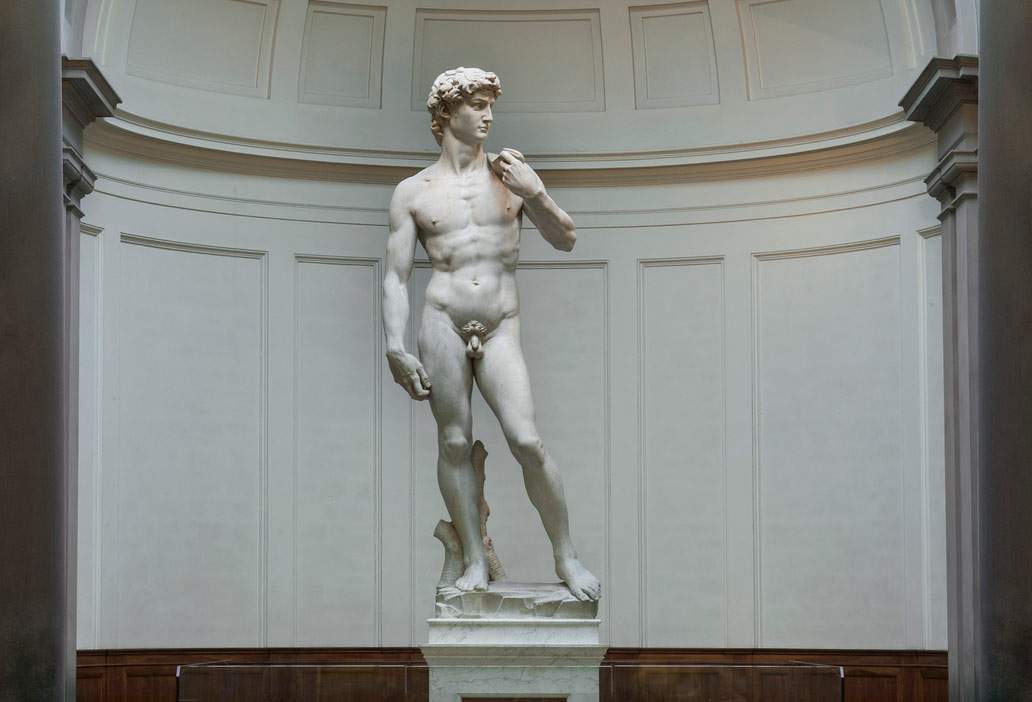 |
| Michelangelo, David (1501-1504; marble, altezz 517 cm including base; Florence, Galleria dell’Accademia) |
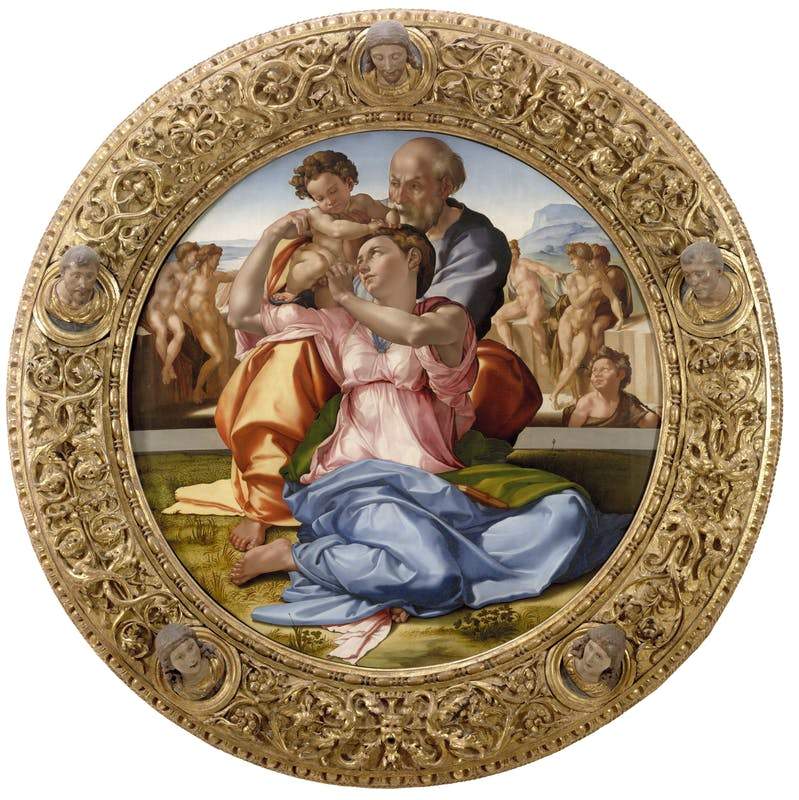 |
| Michelangelo, Tondo Doni (1506-1507; tempera grassa on panel, 120 cm diameter; Florence, Uffizi Gallery). Ph. Credit Finestre Sull’Arte |
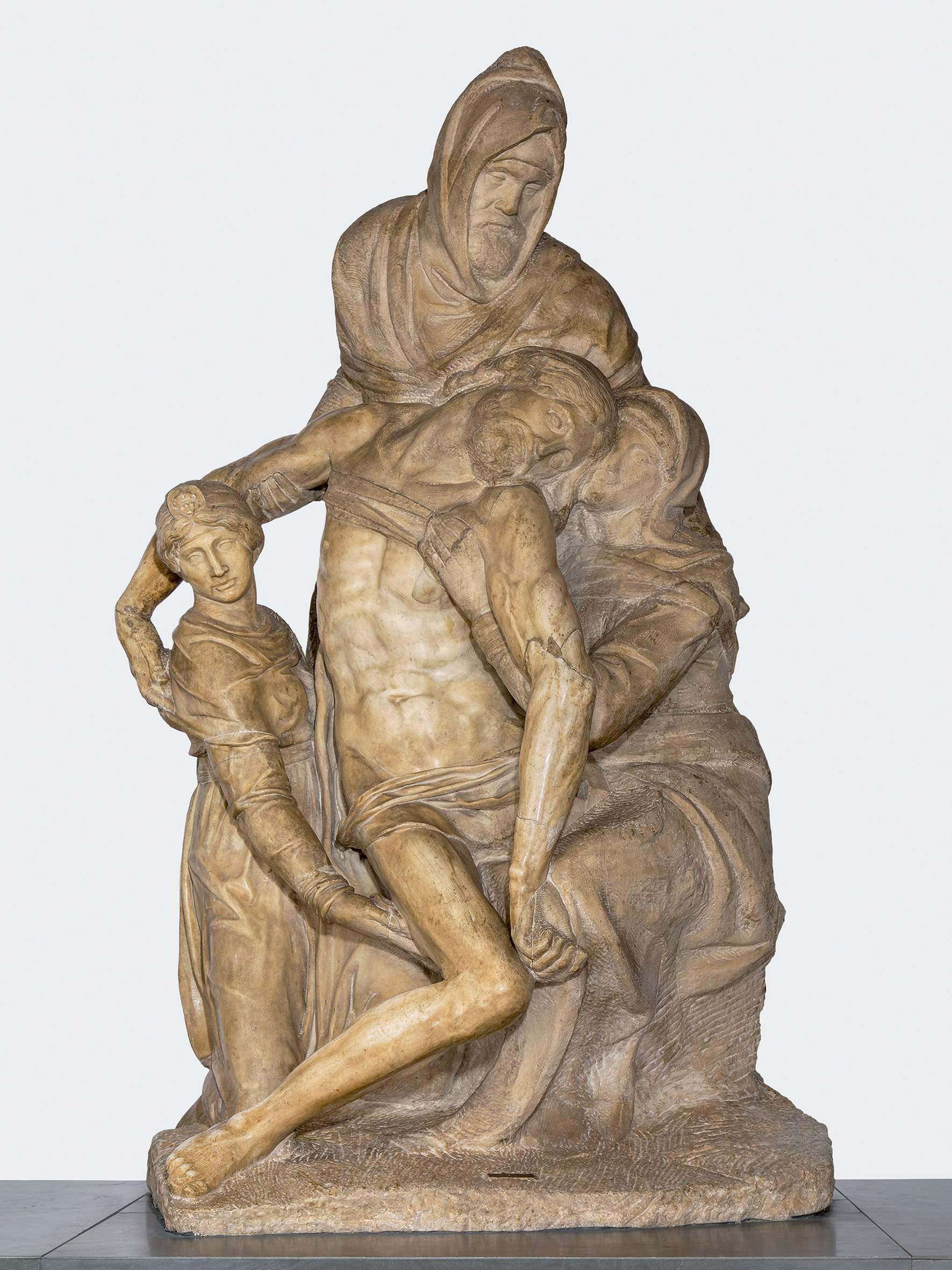 |
| Michelangelo, Pietà Bandini (c. 1547-1555; Carrara marble, height 226 cm; Florence, Museo dell’Opera del Duomo). Ph. Credit Alena Fialová |
Michelangelo Buonarroti’s works are mainly found in Florence and Rome. In Florence it is mandatory to visit the Accademia Gallery (which houses the David and the Prisoners), the Uffizi (where the Tondo Doni is located), the Bargello Museum (which houses the Bacchus, the Pitti Tondo, and the Brutus), as well as the Museum of the Medici Chapels, from which you can access the New Sacristy, and the Museo dell’Opera del Duomo, which houses the Bandini Pietà. But there are also other places in Florence and Tuscany to admire his masterpieces: in Florence, Casa Buonarroti, Santo Spirito, the Accademia delle Arti del Disegno and Palazzo Vecchio; in Siena, the Duomo. At this link you will find ideas for a tour of Tuscany to discover Michelangelo’s “unusual” works.
In Bologna you can see, in the Basilica of San Domenico, the early works that Michelangelo executed for the Ark of San Domenico. Finally, many of Michelangelo’s works can be found in Rome: in St. Peter’s there is the Vatican Pieta, in San Pietro in Vincoli it is possible to admire the tomb of Julius II with the Moses, in the basilica of Santa Maria Sopra Minerva the Christ of Minerva, not to mention the Sistine Chapel where you can admire the vault and the Last Judgment. Also in Rome, the frescoes in the Pauline Chapel are his. In the immediate surroundings, in Bassano Romano, in the Monastery of San Vincenzo, is instead the first Christ of Minerva, considered by some scholars to be the first version of the Christ of the Basilica of Minerva in Rome. Finally, the last Italian city to host a work by Michelangelo is Milan: at the Castello Sforzesco one can see the Pietà Rondanini, his last work.
And abroad? There are only three places that house works by Michelangelo: in Bruges, the Church of Our Lady houses the famous Bruges Madonna, which the artist created for the Flemish Mouscron family, who traded in textiles with Italy; in London, the Royal Academy of Art houses the Tondo Taddei; and finally, the Louvre houses the Dying S lave and the Rebel Slave.
 |
| Michelangelo Buonarroti: life, works, masterpieces |
Warning: the translation into English of the original Italian article was created using automatic tools. We undertake to review all articles, but we do not guarantee the total absence of inaccuracies in the translation due to the program. You can find the original by clicking on the ITA button. If you find any mistake,please contact us.